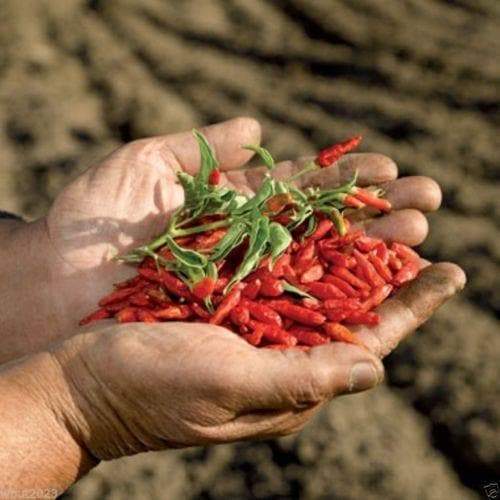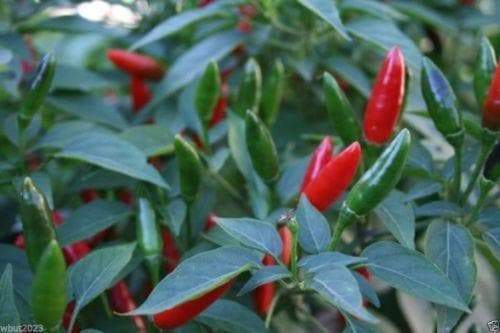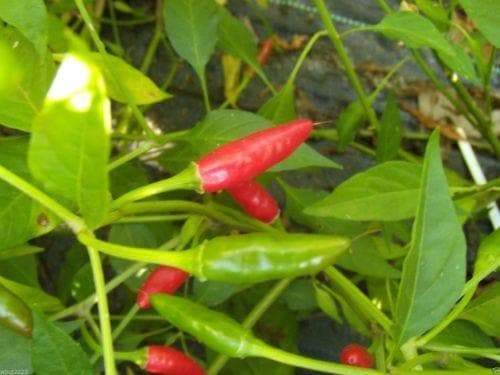
African Bird’s Eye Chili seed ,Capsicum frutescens, HEIRLOOM
Most orders are processed by the next day
Select your desired size and/or color from the available options.
Pepper, Hot, Chili, African Bird's Eye Chili ,used in African And Portuguese cuisine extensively - AKA Malawi bird Chili, Piri Piri,
Piri Piri (also under its other name of African Devil/African Bird’s Eye after the chillis that are used) has its origins in East Africa and is used in Portuguese cuisine extensively
The African Bird's Eye Chili Eye belongs to the species Capsicum frutescens, a species which also Tabasco variety belongs. These peppers are 1 to 2 cm long, have a diameter of half a centimeter and are very hot. Across Africa they occur (even in the wild. The height of this plant can vary from 30 cm. 120 cm. They are known as the pepper to make piri-piri dishes.
African Birds Eye Chili is also widely used in Asian cuisine. The pepper is ideal for drying and grinding into chili powder afterwards. It is very suitable for growing in pots.
Peri-Peri
In Swahili, they are known as Peri-Peri, Piri-Piri, Pili-Pili or Peli-Peli. Belonging to the Capsicum frutescens species, these tiny, bright red pods flourish in the hilly areas of the South-eastern African countries of Malawi, Mozambique, Zimbabwe and South Africa. Its wild varieties are no less than two centimetres long.”
Native to South America, Portuguese explorers introduced the chilli to Africa in 1487. The humid tropical climate and nutrient rich red soil create a healthy amount of stress to produce the perfect fiery element that gives the chilli its unique pungent flavour. The smaller the pod, the spicier the flavour.
With a Scoville (SHA) heat measurement around 80,000 to 150,000 – this African red devil is rated near the top on the world’s hottest pepper scale – Bhut Jolokia (ghost chilli) tops the fiery list. Capsaicin is the chemical responsible for the chilli’s spiciness. Interestingly, capsaicin does not affect birds — making them excellent chilli pollinators.
Addiction, Endorphins and more…
A “delicious wholesome” addiction, aficionados adapt to its heat, and crave more to relive their initial experience. Too hot for your tongue! Down it with a sweet late harvest wine, sparkling grape and apple juices or dairy products like milk and yogurt. Consuming a tiny pod not only ignites the taste buds, but also stimulates the brain to release endorphins — creating a surge of exhilaration, pain and euphoria.
Health Benefits
A walking encyclopaedia on Peri-Peri, Schaetzl emphasized that chillies in general are a great cleansing agent, rich in antioxidants — contain Vitamin B1, B2, B3, folic acid, potassium, phosphorus, iron and calcium — has no fat, high in dietary fibre and low calorie count. The natural antibiotic — capsaicin in the chillies delay microbe growth in the human body and also food products. Consuming chillies improve blood flow, metabolism and stimulate the appetite.
Peri-Peri is rich in vitamins and minerals — and holds metabolism enhancing and curative properties. The green variety is packed with Vitamin C. The red genre has more Vitamin A than fresh carrot — and sun drying increases the carotene content.
description
The plants are perennial and sometimes produce for three years before they are plowed under. Depending on growing conditions, the plants range in height from one and a half to four feet tall, and are usually very bushy. The leaves vary in length from 1 ½ to 3 inches and in width from ½ inch to 1 inch. The fruits generally measure between ½ and 1 inch long and taper to a blunt point. Immature pod color is green, mature color is bright red.
common names
& nomenclature
Pili pili is the Swahili word for 'pepper pepper'. Other English language spellings may include pili pili in the Democratic Republic of the Congo or peri peri in Malawi, deriving from the various pronunciations of the word in parts of Bantu languages-speaking Africa. Piri piri is the spelling of the name as used in the Portuguese language, namely in the Portuguese-speaking Mozambican community.
Also known as:
cayenne, africa pepper, american pepper, bird pepper, capsicum, chili pepper, cockspur pepper, goat's pepper, pod pepper, red pepper, chilies, chili pepper, garden pepper, african red pepper, american red pepper, spanish pepper, zanzibar pepper, capsicum, piri piri, and peri peri
where in the world
habitat and range for african bird pepper
African Bird Pepper grows in Malawi, South Africa, Ghana, Nigeria, Zambia, Zimbabwe, Mozambique, and the tropical forests of South Sudan & the southern half of Ethiopia. It was brought to Goa by the Portuguese and the plant subsequently adapted to the hot climate.
Instruction
PEPPER
Sow seeds indoors ¼" deep. Peppers germinate best in warm soil, so gentle bottom heat may be helpful until seedlings emerge. Wait to transplant outdoors until soil is warm.
Pepper varieties come from tropical humid regions. The temperature, moisture, and air circulation all play a role in growing plants from seeds. Too little heat, too much moisture, and lack of air circulation will cause poor results. Do not use jiffy peat pots, plugs, or potting soil as the soil becomes too dry or too wet, which can lead to disease and fungus. We have experienced disease and low germination when using these types of products. Use Organic Seed Starting Material for best germination results.
Peppers often like to take their sweet time germinating. They can be up in a week, and some will take almost a month. Even with paper towel germination testing, they can take long. I am not sure why, but it is a normal occurrence. So plan and make sure you start them early enough! Also, remember they like heat to germinate so make sure you have a heating mat or something to keep the soil warm. Placing them up on top of the fridge often works too since it is normally warmer up there.
Growing Peppers:
Peppers, like tomatoes, grow in well-drained fertile soil. Almost all peppers have the same requirements for successful growth. Plant them in good, well-drained, fertile soil – and make sure they get lots of sunlight and a good inch of water per week. In many ways, they mimic the same requirements needed for growing great tomatoes.
At Planting Time:
We plant all of our peppers with a good shovel full of compost in the planting hole, and then give them a good dose of compost tea every few weeks for the first 6 weeks of growth. We also mulch around each of our pepper plants with a good 1 to 2″ thick layer of compost.
Peppers do very well grown in pots.
Select your desired size and color from the available optionLET OUR CUSTOMER SPEAK FOR US

![[Seeds] - Caribbeangardenseed](http://caribbeangardenseed.com/cdn/shop/files/gift-card-gift-card-1_1024x1024_dfa857db-9150-4315-a362-7f0bb3fb9c47_60x28.png?v=1703978838)


